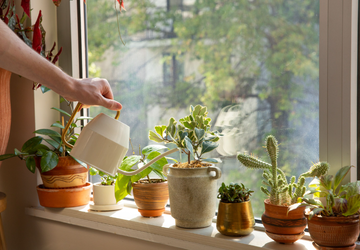Hey there, plant lovers and indoor enthusiasts! If you've ever wondered how to improve the air quality inside your home or office, you're in for a treat. We're diving into indoor plants and how they can make your air fresher and healthier. No need for fancy jargon; we'll keep it simple and spartan.
Why Indoor Air Quality Matters?
Before we get into the nitty-gritty of plant selection, let's talk about why indoor air quality is essential. You see, the air inside our homes and workplaces can be filled with various pollutants. From chemicals in cleaning products to dust and allergens, it's not always as clean as we'd like it to be. Poor indoor air quality can raise health issues like allergies, headaches, and even respiratory problems.
But fret not! There's a natural solution: plants. Certain indoor plants act as air purifiers, filtering toxins and pumping fresh oxygen. Plus, they add a touch of nature to your indoor space, making it more pleasant and inviting.
The Right Plants for the Job
Now, let's get to the good stuff – choosing the right plants to boost indoor air quality. Not all plants are created equal in this regard, so here's a handy list of some superstar air-cleaning plants:
1. Spider Plant (Chlorophytum comosum)
This is a great plant for beginners. Spider plants are low-maintenance and excellent at removing air pollutants like formaldehyde and xylene. They have long, arching leaves with white stripes, giving them a unique look.
2. Snake Plant (Sansevieria trifasciata)
The snake plant is your best friend if you're known for your black thumb. It can survive in low light and neglect, making it nearly indestructible. It's also an ace at removing formaldehyde and benzene.
3. Peace Lily (Spathiphyllum)
The peace lily is visually stunning with its elegant white blooms and an effective air purifier. It can rid the air of ammonia, benzene, and formaldehyde. Just be mindful if you have pets, as it can be toxic to them if ingested.
4. Boston Fern (Nephrolepis exaltata)
For those looking to add a touch of lush greenery to their space, the Boston Fern is a fantastic choice. It's a champion at removing pollutants like xylene and formaldehyde. It does require a bit more care, though, as it likes humidity and regular watering.
5. Aloe Vera (Aloe barbadensis miller)
Aloe vera isn't just for soothing sunburns; it's also an air-purifying powerhouse. This succulent can help eliminate formaldehyde and benzene. It's easy to care for – just let the soil dry out between waterings.
6. Rubber Plant (Ficus elastica)
With its broad, glossy leaves, the rubber plant is an attractive addition to any room. It excels at clearing the air of pollutants like formaldehyde. Make sure to keep it out of direct sunlight and water it moderately.
7. Pothos (Epipremnum aureum)
Pothos, known as Devil's Ivy, is a versatile and resilient plant. It can thrive in low light conditions and effectively remove pollutants like formaldehyde and xylene. This trailing vine looks great in hanging baskets or climbing a trellis.
8. Bamboo Palm (Chamaedorea seifrizii)
If you're after a tropical vibe, the bamboo palm is your go-to plant. It's excellent at filtering out formaldehyde and is relatively low-maintenance. It does best with indirect sunlight and consistent watering.
How Many Plants Do You Need?
Now that you've got a list of potential air-purifying plants, you might wonder how many you need for your space. The general rule of thumb is one medium-sized plant (6-8 inch pot) per 100 square feet of space. So, two medium-sized plants should do the trick for an average-sized living room of around 200 square feet.
However, don't be afraid to mix and match! Combining different types of air-cleaning plants not only improves air quality but also adds visual interest to your indoor oasis.
Caring for Your Indoor Air Heroes
Plant selection is crucial, but caring for your green pals is equally important. Here are some basic care tips to keep your indoor air heroes thriving:
Light
Different plants have different light preferences. Most air-purifying plants are happy with indirect sunlight. Avoid placing them in scorching direct sunlight or pitch-dark corners. If your plant looks sad and leggy, it might need more light.
Water
Overwatering can be a plant's worst enemy. Check the moisture level in the soil before giving it a drink. Stick your finger about an inch into the soil – if it's dry, it's time to water. Be sure to empty the saucer under the pot after watering to prevent root rot.
Humidity
Some plants, like the Boston fern and peace lily, appreciate higher humidity levels. You can enhance humidity by misting the plant, using a humidity tray, or placing a small humidifier nearby.
Pruning
Regularly remove dead or yellowing leaves to encourage new growth. Pruning also helps your plant allocate energy to healthier parts.
Repotting
As your plant grows, it may outgrow its current pot. If you notice the roots circling the bottom of the pot or pushing through the drainage holes, it's time for a bigger home. Typically, repotting every 1-2 years is sufficient.
Keep an Eye on Your Plants and Air Quality
Your plants can also give you subtle hints about the air quality in your space. If you notice yellowing of leaves or browning at the tips, it might indicate air pollution. Don't panic; it's your plants' way of saying they're doing their job by absorbing those nasties.
Regularly dusting the leaves and occasionally giving them a gentle shower can help improve their efficiency in purifying the air.
Conclusion
Choosing the right indoor plants for better air quality is a smart and stylish way to enhance your living or working space. By selecting plants like spider plants, snake plants, peace lilies, and others, you can enjoy cleaner, fresher air and a more welcoming environment.
Remember, it's not just about the number of plants but also how well you care for them. Give them the right amount of light, water, and love, and they'll reward you with better air and a greener outlook on life.




